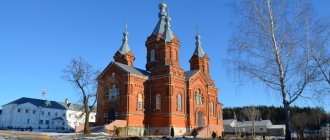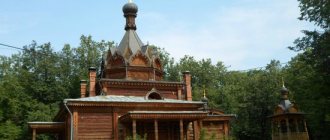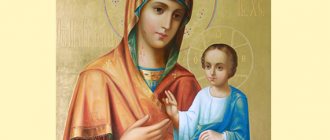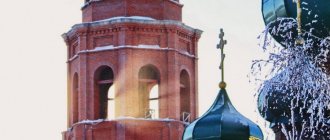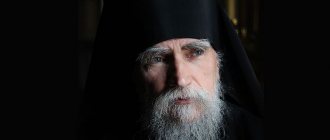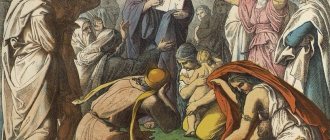Video “Prayer to St. Tikhon of Zadonsk”
Audio recording of a prayer to St. Tikhon of Zadonsk.
Childhood and adolescence
In 1724, the clergyman Savely Kirillov from the Novgorod province had a son, who was named Timofey. Soon the father died, leaving a widow with five children. Seeing the disastrous conditions that the family endured, one childless rich coachman offered to adopt the boy. The mother agreed with difficulty, but the older brother, who returned from the army, did not allow the woman to do this. He promised that he would find funds and teach the child to read and write.
Until the age of 14, Timofey lived with his mother. Their life was very poor, and therefore the boy ate black bread, washing it down with water. When the opportunity arose, he worked in the landowner's field to bring home at least some food.
Soon, a decree of Empress Anna was issued, according to which all illiterate children from clergy families must serve their homeland. To save her son from military service, the mother decided to send him to a theological seminary. Thanks to his older brother, Timofey quickly settled in a new place, starting his educational path.
years of education
The boy had a strong thirst for knowledge, and therefore he was soon transferred to free education. Despite this, Timofey was still in dire need of funds. He was forced to give up part of his rations for money in order to buy candles. Such poverty often became a source of jokes among the other students. However, the young man was never angry with his offenders, continuing to scrupulously study literacy.
The efforts of the future monk were not in vain. He studied better than anyone, and always passed exams only with the highest marks. He achieved heights in rhetoric, theology, grammar, and when he graduated from the seminary, he was appointed teacher of Greek. Timothy also taught theology and eloquence part-time.
Among his colleagues, the young man was distinguished by his modesty, goodwill, and piety. It was while teaching at the seminary that the future saint finally realized that he must follow the path of God. He began to study the Gospel even more carefully and pray tirelessly.
Period of monasticism
April 1758 marked the beginning of Timothy's monastic path. Having taken monastic vows, he was named Tikhon. Next, the monk went to St. Petersburg, where he soon became a hieromonk. Having received a teaching position at the local seminary, the future saint taught philosophy to students, and was later appointed prefect.
A few years later, the monk moved to the Tver province, where he received the rank of archimandrite of the Zheltikov Cathedral. There he became abbot and continued his teaching activity, reading theology to students at the local seminary. At the same time, the saint writes his first work, where he describes the principles of the Christian faith.
Other clergy prophesied the highest ranks to the archimandrite, but the Almighty decided otherwise. When the time came to appoint a new bishop, everyone unconditionally pointed to the saint. Thus, Tikhon Zadonsky at the age of 37 becomes the spiritual teacher of all Rus'.
Life of Tikhon of Zadonsk
Life at peace
Fulfilling the duties of a bishop left its mark on the health of the saint. Feeling a deterioration in his health, he left his position in 1767 and returned to the ascetic monastic life. The monk spent his days reading prayers, Holy Scripture, and composing his own works. He visited the temple every day, praying for the salvation of all the laity.
Tikhon traveled a lot to different monasteries, giving all his money to the poor. One day he visited Yelets, where he met with prisoners to guide them on the right path. God endowed the saint with the gift of foresight, the ability to perform miracles, and also to read minds. The miracle worker loved to communicate with people, helped those in need, consoled, listened and gave advice.
The saint died on August 13, 1783, and exactly 78 years later he was canonized, elevated to sainthood.
Relatives of St. Tikhon and their descendants
Elder brother of St. Tikhon Efim begs his mother Domnikia not to give little Tim to the coachman
Now let's talk in more detail about the nephews and some other relatives of St. Tikhon. As Tikhon Zadonsky’s cell attendant Vasily Ivanovich Chebotarev recalled, Tikhon Zadonsky did not remember his father, but the family had four sons and two daughters. Two older brothers Efim and Peter followed in their father's footsteps. Efim took his father's place in Korotskoye, and Peter served as a sexton in Novgorod.
While at the Novgorod See, Tikhon of Zadonsk himself elevated brother Efim to deacon, and took his son Philip, 14-15 years old, with him after his appointment to Voronezh. Let us remember that it was brother Efim who once begged his mother Domnikia not to give his little brother Timofey to a childless coachman, who really wanted to take the boy into care from an orphaned poor family and promised to leave him all his inheritance.
Nephew Philip
As the Elagin Life reports, “Philip was brought up in the seminary to the philosophical class, beyond which the teaching in Voronezh did not extend. After his retirement, St. Tikhon Philip lived with him for some time as a cell attendant, then Alexei Bekhteev, the landowner of Lipovka and Ksizovo, begged St. Tikhon his nephew to become a deacon in Lipovka, so that he would eventually become a priest. But the Right Reverend Tikhon said that Philip would not bear the priestly office with dignity. Philip remained a deacon until his death in 1800.” Philip drew well and was a skilled painter. St. Tikhon bought a clean half of a hut in the village of Lipovka for his nephew’s painting workshop. This hut was still preserved at the beginning of the 20th century, but was already used for other purposes (poultry was kept in it). Philip Efimovich Sokolov (nephew, as I already indicated, took the surname of St. Tikhon) had numerous offspring. Let's talk about some of its representatives.
Great-nephew of St. Tikhona Ivan Dmitrievich Sokolov
Signature of psalm-reader Ivan Sokolov in the Metric Book p. Lipovka, under the birth record of Sergei Bekhteev, the future poet
Philip's son, Dimitri, served as a psalm-reader in Lipovka, subsequently giving up his place to his son Ivan, who rose to the rank of deacon. By the way, the signature of psalm-reader Ivan Sokolov is in the metric book with. Lipovka under the entry made in it about the birth of the future Russian poet Sergei Bekhteev (April 7, 1789). We see his signature in the registry book under the death certificate of the father of the poet Bekhteev, also Sergei Sergeevich (07/07/11/1911)
In 1912, on the anniversary of the death of S.S. Bekhteev, his numerous relatives came to Lipovka, among whom were the Tolstoy couple (Peter Sergeevich and Zinaida Sergeevna, who was the daughter of the deceased) with their son Sergei. In his memoirs, Sergei Tolstoy, already an elderly man himself, recalls the elderly deacon Ivan Dmitrievich, whom he saw on the anniversary of his grandfather’s death, and points out his distant relationship with St. Tikhon: “Now I want to write a few words about Ivan Dimitrievich. He was a native of Lipovka, where he lived all his life as a deacon and, when he grew old, left this ministry. I remember him dressed in a cassock, with a large belt, with a kamilavka, with long hair and a beard, and in his hands was a club. They said that he was a distant relative of St. Tikhon of Zadonsk; had many children, and three sons reached the bishopric.” I don’t know whether Sergei Petrovich Tolstoy’s information regarding the bishopric of the three sons of I.D. Sokolov is accurate? It would be good to check this information. Mentions of I.D.’s adult children Sokolov are also found in other sources:
Signature of Deacon Ivan Sokolov under the record of the death of Sergei Sergeevich Bekhteev (the poet’s father)
Thus, in the magazine “Voronezh Antiquity” (No. X, p. 206) the following is said about them:
- 1.Ivan Ivanovich (Sokolov), deacon in Ksizov, Zadonsk district.
- 2. Sergei Ivanovich (Sokolov), priest in Staro-Nikolsky, Nizhnedevitsky district.
- 3. Veniamin Ivanovich (Sokolov), priest in Dubovoy, Zadonsk district.
- 4. Pavel Ivanovich (Sokolov), head of some station on the South-East railway.
The brother of Ivan Dmitrievich Sokolov, Alexander Dmitrievich, served as a psalm-reader in the village. Pushkarsky. He had sons: Pyotr Alexandrovich - a painter who lived in Yelets before the revolution in his house on the street. Orlovskaya, and Ivan Alexandrovich, regent at St. Isaac's Cathedral in St. Petersburg.
All relatives of St. Tikhon had a rule to gather on the day of remembrance of the saint, August 13, in Zadonsk. Almost everyone had some things or holy icons that once belonged to St. Tikhon. In “Voronezh Antiquity” (p. 206 of the uk. op.) it is said about another relative of St. Tikhon: priest of the Zhabsky Kubratov farm, Valuysky district - Fr. Andrei Ivanovich Sokolov.
Great-nephew Ioann Efimov - builder of the Sofia Usmansky convent
Former Usman Sophia Convent
The identity of this relative of St. Tikhona is bright and mysterious in many ways. Almost all biographers of St. Tikhon of Zadonsk refer to the memoirs of his cell attendant Ioann Efimov, but none of them seems to mention their blood relationship. Probably, for some reason, John Efimov kept his family relationship with Saint Tikhon in strict confidence, which became known only after his death. We actually know nothing from the biography of John Efimov himself, except that he was the son of Tikhon of Zadonsk’s own nephew named Efimy. But whose son was Efimy himself? Which brother or sister of the saint? - we don’t know.
There is information that Efimy was a deacon and lived in the Tolshevsky Monastery, which is located not far from Voronezh. Thus, an indisputable fact is revealed to us: Saint Tikhon brought with him to Voronezh not only one nephew Philip, but two at once, and even the son of his second nephew. At the same time, the saint himself did not ordain any of his relatives to the priesthood, but only to the rank of deacon. In other words, there is no need to talk about any special patronage on the part of His Eminence Tikhon towards his relatives. Moreover, he did not even give his blessing to ordain Philip’s nephew to the priesthood (which the landowner Alexei Ivanovich Bekhteev asked him to do), citing the fact that Philip would not be able to bear this high name with dignity.
From the life of St. Tikhon, we know that first, after retiring from the episcopal see (late 1767), he settled in the Tolshevsky Monastery. However, the swampy, damp climate of that area turned out to be completely unsuitable for his weakened body, and therefore, during Great Lent in 1769, Saint Tikhon moved to the Zadonsk Monastery, where he stayed for more than 14 years, until his righteous death.
John Efimov was with Saint Tikhon as a cell attendant, replacing his other relative, Philip, mentioned above. After the death of St. Tikhon of Zadonsk, most of the saint’s personal belongings were given to the cell-attendant John in the will of the deceased. There is conflicting information about exactly when John Efimov became a monk: according to some sources - in 1780, that is, during the life of St. Tikhon; according to others, it happened somewhere at the beginning of the 19th century. Metropolitan Gabriel (Petrov-Shaposhnikov) of Novgorod and St. Petersburg tonsured John, and he elevated John to the rank of deacon, and after some time to the priesthood.
The monastic name of John became, of course, the name Tikhon. After the death of Saint Tikhon, Hieromonk Tikhon left for Moscow, where he lived with the brethren in the Stavropegial Novospassky Monastery. In those years, the daughter of Major Fedorov, one of the Usman admirers of St. Tikhon, Nadezhda, who received an inheritance after the death of her parent, decided to use it to build a convent. Its decision was approved by the Holy Synod in 1800. To manage the construction, an authoritative person of an ascetic nature was needed. The choice fell on Hieromonk Tikhon (Efimov), sent from Moscow to carry out that responsible mission. Thus, by the providence of God and for the glory of God, the paths of a relative of St. Tikhon and the daughter of his late admirer crossed.
Usman Sophia Monastery
Thanks to the diligence and skillful management of the construction of Father Tikhon, the Usman Sophia Convent was erected. From Hieromonk Tikhon a number of personal belongings and icons of the saint were transferred to this monastery for safekeeping. The valiant builder and beautifier of the monastery, Hieromonk Tikhon himself, departed to the Lord in 1812. On November 7, his burial took place in a special cave under the monastery cathedral. A cast-iron slab with the inscription was placed on his grave with the inscription: “Here is buried the builder of the Sophia nunnery of the Moscow Stavropegial Novospassky Monastery, Hieromonk Tikhon, cell attendant and grandson of the Most Reverend Tikhon 1st of Voronezh and Zadonsk, in the world Ioann Efimov, son of the deacon of the Tolshevsky Monastery Efimiya, nephew of the Eminence Tikhon Zadonsky. He died while fulfilling the obedience given to him by the Holy Synod near the monastery he erected in 1812 (October 31); buried on November 7. Eternal memory to him"
This wonderful monastery existed from that time until 1924. Many of the last nuns of the monastery ended their earthly lives as martyrdom: in exile, camps, and prisons. The last abbess of the monastery (in the world Alexandra Sergeevna Yudina), in order to feed herself, washed floors, sewed blankets, and did any feasible work. However, even in this situation, it remained not only alien, but also dangerous for the new government. Soon informers were found; the names of some of them became known after the partial declassification of NKVD files during the years of perestroika. This is a certain M.V. Azarova and I.I. Frolov. The sin of parents, as we know, falls on their children up to the third or fourth generation...
52 years after the execution of the abbess (her monastic name is unknown), by the Decree of the Presidium of the Supreme Soviet of the USSR dated January 16, 1989, the former abbess of the Usman Sophia Monastery, who had innocently suffered from the atheistic authorities, was posthumously rehabilitated. Eternal memory to her. The fate of the monastery buildings themselves is interesting and indicative. In the mid-30s, a colony for minors was opened here. During the war years (from April 28, 1942), a special camp was organized on the territory of the former monastery for Soviet soldiers and officers who were captured by the Germans. In 1943, this one of many special camps of this type held up to 4,000 people.
Since 1944, the camp has become a refuge for prisoners of war. And since 1946, the colony was returned to the former monastery, which exists there to this day. About 10 years ago I had to give a talk to the inmates of this colony, which at that time also housed juvenile murderers. I knew nothing then about the history of the monastery, but I remembered part of the surviving church building. True, little has survived from the magnificent monastery composition, but what has survived has amazed us with its extraordinary beauty and grandeur.
“Spiritual Treasure” and other books
According to theologians, the work of Tikhon of Zadonsk was influenced by German pietism, and especially the books of Johann Arndt. Tikhon Zadonsky began writing “Spiritual Treasure” in four volumes after he left his position as bishop. In addition to this work, other works came from the pen of the saint:
- about the principles of Christianity;
- letters from cells and sent;
- about the gospel teaching;
- moralizing words;
- sermons of diocesan works.
All the work of the saint is permeated with deep edifying wisdom, bringing salvation and leading to God. The works of St. Tikhon became available to the laity in March 1784, after the decision of the Holy Synod.
In 1875, a collection of all the works of the miracle worker was published, presented in the chronological order of their writing.
Miracles through prayers to the saint
Saint Tikhon helps everyone who sincerely asks. Prayers to him perform miracles where medicine is powerless. Below are just a few cases of miraculous healing:
- Doctors could not cure a nun suffering from liver cirrhosis, and with her last hope she turned to the image of the saint in Zadonsk. After a long prayer, the disease subsided.
- One woman’s husband was dying of cholera. She prayed to the miracle worker for a long time to save her husband, and he soon recovered.
- Many witnesses said that the monk came to them in a dream after prayer, and in the morning they woke up healthy.
Orthodox texts
Many prayers are addressed to Saint Tikhon. Churches annually hold services with prayers for the repose of the saint’s soul.
Prayer
O great saint of Christ and monster Tikhon! Hear us, sinners, as we come to you with warm faith and tender prayer. We have the angelic blessing of your life on earth, we glorify your mercy to all, we adore the height of your Christian virtues and even in our time we prosper thanks to the glorified God of God. You are truly a good shepherd, the verbal flock of Christ, the sacraments of God, a valiant builder, a pillar and adornment of the Orthodox Church, the Russian Chrysostom, a strong eradicator of pagan customs, a skilled interpreter of the teachings of the Gospel, a zealous bishop of the saints of the Fathers' traditions, the amateurish silence of a monastic, an inspired collector of the wisdom of spiritual treasures from visible things of this world, the wisdom of God created. You, as a chosen vessel of grace, have impersonally taught all who long for salvation through the word, life, love, Spirit, faith, purity and humility. You were a merciful protector of fathers, a contemplator for widows and the poor, and a ready comforter for all who found themselves in trouble and misfortune. And now we, as if standing before the face of the Lord, are glorious and trust in Him; For this reason, father, let us find refuge and fervently pray to you: be for us all at the Throne of the Most High. May He forgive our iniquities and injustice; may he enlighten our mind, darkened by vanity, and direct it to the true light of the knowledge of God; may our weak heart be protected from the lustful, sinful flattery and rotten wisdom of this age; May the earth give the earth its proper watering of rain, fruitfulness and everything that is beneficial to us, even for temporary and eternal life, so that everything that flows in the stream of your imperishable prayers may find peace, love and serenity. Our Church, ask the Heavenly King for mercy, prosperity, salvation, but also victory and victory over your enemies. Our homeland is protected by peace and quiet, save your saint from all temptations and teach us all to walk with reverence and fear of God in the ways of God’s commandments; Remember, the mercy of Christ to Holy Father Tikhon, in your holy prayers and in the souls of the dead, our fathers and our brothers, that the Lord will rest them in the villages of heaven; Do not despise our sigh, that I may take away the glorification of the Father and the Son and the Holy Spirit, now and always, and unto ages of ages. Amen.
Troparion
From his youth he loved the blessed Christ, / the image of everything was word, life, love, / spirit, wind, purity and humility, / he also dwelt in the midst of heavenly / prayers / objectified / for our souls to be saved.
Kontakion
The apostles are the successors, / the adornment of the saints, / the Orthodox Church to the teacher, / the Lord of all prayers, / the peace of the universal gift // and mercy for our souls.
Veneration of Saint Tikhon of Zadonsk
The saint is deeply revered throughout the Orthodox world. After all, it was he who prevented atheism from finally taking root in the 18th century, turning more and more people to the true faith.
Memorial Days
The saint is commemorated several times a year:
- August, 26th;
- September 17;
- 23 September.
Also, the day of remembrance falls on the Cathedral of Tver Saints.
Typically, icon painters depict the miracle worker from the waist up or to his full height.
Where are the relics located?
During Soviet rule, the shrine belonged to the museum for a long time. Only in 1988 it was transferred to the cathedral of the Oryol diocese. Three years later, on the day of remembrance of the miracle worker, the relics were finally returned to the Vladimir Church of the Nativity of the Virgin Mary monastery in the city of Zadonsk.
Icons of the saint
The first portraits were painted during the life of the saint. Today, images of the saint can be seen in many churches across the country in the form of icons, frescoes, paintings or mosaics. Sometimes, next to Tikhon of Zadonsk, you can see St. Mitrophan of Voronezh on them.
Typically, icon painters depict the miracle worker from the waist up or to his full height. The saint always wears a bishop's attire, as a symbol of holiness and high rank. The monk holds the staff with his left hand, and his right hand is raised for blessing.
Seminary training. The beginning of the monastic path
At the age of thirteen, Timofey was assigned to a theological school that functioned at the Novgorod Bishops' House. The poor mother, of course, did not have the means to pay for her son’s education, but here again his older brother, Peter, intervened, promising to take over Timofey’s maintenance at the school. Timofey himself, knowing how hard it was to get the funds he needed, whenever possible, he worked part-time where he had to.
Soon the school was transformed into a seminary. Timofey studied diligently and in 1740, among the best students, continued his studies at the seminary at public expense. He approached education with all responsibility. Often, while his peers allowed themselves to play and be naughty, he sat behind his textbooks. It happened that he sold part of the ration, bought candles with the proceeds and read at night.
It happened that frivolous peers made fun of him, censing him with their bast shoes and addressing him with mocking dignities.
Due to the seminary not being fully staffed with teaching staff, the training lasted longer than the usual regulated period.
In 1750, while a student in the theological class, Timofey, having proven his worth to the leadership, began teaching Greek, for which he received a 50-ruble salary and some flour. Later, after completing the course, he was entrusted with the position of teacher of rhetoric and philosophy.
In April 1758, one of Timothy's most cherished desires came true: he took monastic vows. Then he was given a new name - Tikhon. During this period he took the place of prefect of the seminary.
Soon he was called to St. Petersburg and ordained a hierodeacon, and then a hieromonk.
In 1759, Father Tikhon was sent to the Tver diocese, and upon arrival in Tver he was elevated to archimandrite of the Zheltik monastery. Somewhat later, he was sent to the Otroch Monastery and appointed to the post of rector of the Tver Seminary. During this period he established himself as a teacher of Theology.
Prayer to Tikhon of Zadonsk
You can ask the saint for a miracle in the temple. If you can’t visit church, you can read the prayer at home.
After himself, the great Russian theologian left a large number of wise covenants. His instructions are still followed, instilling in the younger generation a love for God and a desire to follow the righteous path.
Prayer to Saint Tikhon the Wonderworker of Zadonsk, Bishop of Voronezh. Saint Tikhon of Zadonsk is a great Christian teacher and preacher, a missionary and eradicator of pagan superstitions and customs, an extraordinary ascetic and man of prayer, an archpastor imbued with humility and love for his flock. He had the gift of clairvoyance and miracles. Saint Tikhon of Zadonsk is the heavenly patron of monks and church clergy, missionaries and catechists, and seminary students. They pray to Saint Tikhon for the gift of meekness and gentleness, ascetic deeds, for deliverance from any illnesses, but especially from mental illnesses: sadness and despondency, from alcoholism and drug addiction, mental insanity and demonic possession. Saint Tikhon helped a considerable number of people regain their sight and the ability to walk; they also turn to him for help in extreme need and poverty.
If you find an error, please select a piece of text and press Ctrl+Enter.
Sorrowful affliction
“Despondency is a grave torment of the soul, an unspeakable torment and a punishment more bitter than any punishment or torment,” St. John Chrysostom says about despondency.
“Do sinners who are careless about the salvation of their souls suffer from despondency? Yes, and most often, although, apparently, their life consists mostly of fun and pleasure. Even in all fairness, we can say that internal discontent and secret melancholy are the constant lot of sinners,” testifies Saint Innocent of Kherson.
Punishment for sinners. What about the saints?
The famous Russian saint of the 18th century Tikhon Zadonsky (1724-1783) until the end of his life could not free himself from severe attacks of despondency, “melancholy and hypochondria,” as he himself wrote, although he struggled with them all his life. There were no medicines. All I had to do was endure.
Was he inclined to black melancholy initially, due to his mental make-up, that is, did his illness have endogenous roots?
We will not know this, but obviously, the events of childhood - the early death of the sexton father, extreme poverty, the need to always ask for something, and, already in the seminary, the ridicule of his comrades at the “lapotnik”, because Timothy, as the saint was called before his tonsure, he didn’t even have boots - all this affected the health and mental state of the physically fragile boy.
From his youth, the saint loved to be alone, and already in the seminary he dreamed of becoming a monk. At the age of 34 he was tonsured, and already at 37 he became a bishop. He was known to Empress Elizabeth Petrovna as a priest “for the sake of Jesus, and not a piece of bread” and a sincere mentor.
Already ordained as a bishop, Bishop Tikhon once met his own sister: he, in magnificent vestments, emerging from a carriage, she, out of poverty, was a widow washing the floors of strangers.
The fate of her brother struck her. The saint recalled how she, crying, said that she remembered now, “in what poverty she and her mother were brought up, that over time, we were deprived of daily food. And now I see you in such a high rank!” She called her brother “you,” and the bishop cried.
Having learned how his early widowed, childless sister had to live, Vladyka Tikhon ordered the floors to be finished immediately, bought a light, small stone house (on a foundation) with ficus trees in the windows, gave it to his sister, assigned a monetary income from his share and ordered him to hire a woman for cleaning, and From then on, his sister looked after his episcopal vestments.
Vladyka Tikhon often visited his only dear soul, but his sister lived in what she herself said was paradise, only a month and died - her poor health took its toll.
Vladyka performed a funeral service and buried her, shedding tears, and when, “in the manner of the bishop’s service, I venerated the holy icons, went to the coffin, opened the lid and overshadowed her body, she seemed to smile at me,” he later wrote.
